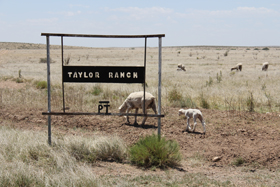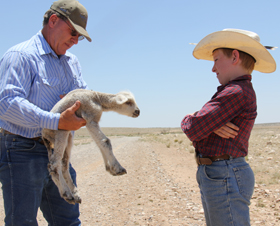
- August 2014
- President’s Notes
- Market Report
- Letters to Vilsack Express Industry Concern Over Grazing Allotments
- Sheep Experiment Station Granted New Life
- News Briefs
- Amidst Drought and Predators, Some Texas Wool-Sheep Producers Vow to Stick it Out
- Ohio Sheep Day: Annual Event’s Goal is to Keep Sheep State’s Infrastructure Shipshape
- Let’s Grow: New Mexico Hoping Taylor Ranch Flock Can Help Turn Back the Sheep Clock
- Researcher With Interest in Feed Value of Woody Plants is ASI Scholarship Winner
- Moving Forward in Montana
- Lamb Board’s Direct Marketing Study Aimed at Helping Industry Understand Growing Sector
Let’s Grow: New Mexico Hoping Taylor Ranch Flock Can Help Turn Back the Sheep Clock
As if he’d come upon an unexpected statue of gold in the middle of New Mexico’s open desert, Vernon Crockett in one smooth motion hit the brakes, swung open the driver’s side door and clomped his boots across the gravel road that lay in front of his pickup.
one smooth motion hit the brakes, swung open the driver’s side door and clomped his boots across the gravel road that lay in front of his pickup.
 one smooth motion hit the brakes, swung open the driver’s side door and clomped his boots across the gravel road that lay in front of his pickup.
one smooth motion hit the brakes, swung open the driver’s side door and clomped his boots across the gravel road that lay in front of his pickup.
These were the familiar instincts of a sheep man – a livestock manager who’d spotted a young lamb separated from a ewe and the rest of the flock inside of the vast 220,000-acre operation.
Crockett, who manages a new flock – well, new to New Mexico, that is – of about 10,000 sheep, inspected the lamb, handed it off to his young assistant and then drove it to a nearby holding pen for further care. Crockett’s assistant, his 10-year-old son Colton, inquired about the fate of the lamb.
“I’ll get with one of our herders to let him know about this one and see what we can do,” Crockett said. “With thousands of ewes and lambs out here, it’s hard to say how he ended up all by himself.”
The feeling of “being alone” is not necessarily rare for New Mexico sheep or the state’s sheep producers. Like many comparable states, it has seen a steady decline in its flock. The USDA’s 2012 Census of Agriculture reported about 90,000 sheep and lambs were being raised in New Mexico that year, down from about 127,000 in 2007. A decade ago, that number was above 150,000 – and if you go back 50 years to the 1964 census, you’ll find the number topped 860,000.
“We still have a have been in decline for awhile, but we still have a hardy group of producers and ranchers who dedicated to sheep,” Caren Cowan, president of the New Mexico Wool Growers, noted. “ There is not just one reason. We’re dealing with predators, drought and restrictions caused by endangered species. But we’re hanging tough. I will say that it is encouraging to see someone like Mr. Taylor trying to rebuild the flock.”
A new approach to an old profession
The “Mr. Taylor” Cowan refers to is Paul Taylor III – real estate broker, lamb jerky maker, aspiring agriculture management consultant and owner of sheep.
Taylor Ranch is a partnership of Taylor’s company, Ranchline, and the historic Felix River Ranch. The vast ranch outside of Roswell began a little over a year ago with the purchase of 1,000 ewes.
Taylor called it an “experiment in sheep ranching.”
 “Really, we want to develop a service and consulting business for other ranchers and producers, but our thinking was that we should really have the experience of operating a ranch before that,” he explained. “We bought those 1,000 sheep and had Vernon Crockett to run the operation. Our goal was to see how we did with the first 1,000 before moving forward.”
“Really, we want to develop a service and consulting business for other ranchers and producers, but our thinking was that we should really have the experience of operating a ranch before that,” he explained. “We bought those 1,000 sheep and had Vernon Crockett to run the operation. Our goal was to see how we did with the first 1,000 before moving forward.”
Part of moving forward was tapping into ASI’s Let’s Grow program –Taylor’s sheep ranching “test” involved recruiting four Peruvian herders with the help of Let’s Grow.
“We were learning how to herd sheep, that was new to us,” Taylor said. “We learned and we met our goal. Then we decided it was time to vastly expand our flock, but would we do it here or would we buy another ranch that already had its own flock?”
Taylor made on offer on a ranch belonging to Fred Roberts of Wyoming. That deal did not work out, but during a visit to Roberts’ ranch, Taylor noted the quality of the sheep.
So earlier this year he bought 8,000 ewes from Roberts and moved them from Wyoming to New Mexico. Which brought about a whole new set of challenges.
“First there was the issue of transport, but Fred Roberts did a wonderful job organizing that and we moved the sheep using 31 trucks in eight days,” Taylor said. “After that, the challenge was acclimating the sheep to New Mexico’s climate and landscape. That was what we called ‘Phase One’ of our endeavor.”
Phase Two came shortly after when it came time to shear the sheep in his newly-expanded flock.
“Mike Corn and Let’s Grow really helped us get that going by getting a crew together, and we sheared at three locations for 10 straight days,” Taylor said. “As it turns out, that was necessary, because lambing began exactly two days later.”
Growing the flock
Corn, ASI secretary/treasurer, chairman of the Let’s Grow Committee, owner of Roswell Wool and a member of one of New Mexico’s most historic sheep ranching families, said he is excited to see Taylor and his operation put sheep back on ranch land in New Mexico.
“In years past, those same ranch lands were home to 20,000-plus ewes and they are located right in the middle of some the best sheep country in the state,” Corn said. “I’m also very excited to see them turn the clocks backward and go back to herding. This should be a great eye opener for other producers in our area and maybe just maybe they will see the merit to go back to herding and hopefully it will turn around the predator situation.”
Let’s Grow’s helping hand to the Taylor Ranch is an example of the flexibility of the program. The initiative’s ultimate goal is to ensure that the U.S. sheep industry is sustainable for future producers.
The first summer
Discussing his flock in mid-June, Taylor addressed the next phase of his operation: maintenance.
“We’re going to have to keep them in water over the long, hot New Mexico summer,” he said. “We have to keep in mind the ewes are Wyoming sheep. The lambs will be New Mexico born, but the ewes will have to adjust.”
Predators – mostly coyotes and bobcats – will have to be monitored, as will the herders.
“Some of them are new to this region, and we want to make them feel comfortable,” said Taylor. “They know what they are doing, and that will be a big help. Along with Vernon, we have a good team and I’m confident that we can build upon the history and raise quality sheep here. We plan on being successful.”
Another stab at success is Ranchline’s new gourmet lamb jerky, called “Ch’arki.”
“We’ve been providing cuts of lamb for a few years, but we just started a jerky line,” Taylor explained.
Next steps for Taylor Ranch
Reporting in late July, Crockett said that the ewes from Wyoming were adjusting.
“We’ve had some rain, not as much as we need, but it has helped,” he said. “We’ve been moving the ewes around, and they are in good shape.”
The spring lambs – including the lonely one pulled from the range by Crockett earlier this summer – also appear to be handling the New Mexico summer.
Which means another phase of Taylor’s plan appears to be a success, as predicted.
“What’s next?” Taylor asked himself. “Hopefully, positively, we grow.”

